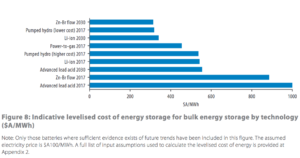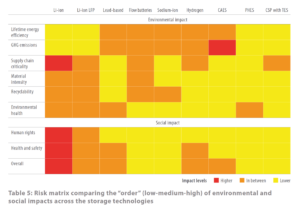Ammonia-Hydrogen Energy Storage Highlighted in Australia
By Stephen H. Crolius on December 07, 2017
A new report from Australia identifies ammonia as a key part of a hydrogen-based high-volume energy storage system. On November 20, Australia’s Council of Learned Academies (ACOLA) and its Chief Scientist released “The Role of Energy Storage in Australia’s Future Energy Supply Mix.” In addition to hydrogen, the report covers pumped hydro, batteries, compressed air, and thermal systems. Its rationale for including ammonia is starkly simple: “Hydrogen gas is difficult to transport due to its low density; instead, it is proposed that hydrogen is converted to ammonia for transport, and then converted back to hydrogen for use.” Although an ultimate ranking of energy storage options is not provided, the hydrogen-ammonia combination arguably emerges as the best option in terms of economics, environmental and social impact, and deployability.
The 158-page document “is the first in a series of ‘horizon scanning’ reports,” according to an ACOLA press release. “By working closely with the Office of the Chief Scientist ACOLA aims to present evidence-based reports on key issues to the Prime Minister’s Commonwealth Science Council to inform policy making and identify opportunities.”
The proximate motivation for the report is a circumstance familiar to all jurisdictions that commit to strong renewable electricity targets: when electricity supply is subject to significant variability and demand must be met constantly and completely, it is advantageous to integrate energy storage. The report’s objective is to study “the transformative role that energy storage may play in Australia’s energy systems; future economic opportunities and challenges; and current state of, and future trends in, energy storage technologies and their underpinning sciences.” It addresses two broad dimensions for each energy storage method: what are its essential characteristics and what factors should be considered in evaluating its fitness for large-scale implementation.

Economics are included in the essential characterization of the energy storage methods, with the “levelized cost of storage” (LCOS) provided as the key metric. LCOS is analogous to the levelized cost of electricity in conventional utility-sector analyses in that it comprehends capital costs, fixed and variable operating costs, and system efficiency. Hydrogen is shown to have a highly competitive LCOS. According to a bar chart included in the text, the cost of pumped hydro falls in a range between A$360 and 530 per round-trip MWh, depending on geographic location. The cost of hydrogen in a “power-to-gas” scenario is about A$460. The least costly battery technology, lithium ion, comes in at approximately A$540. Compressed air and thermal storage systems are not included in the analysis. Although pumped hydro in a favorable location had the lowest LCOS, the report acknowledges that siting of such facilities is constrained by both “geology and water availability.” The comparison’s clear implication is that, save for the situations when these factors are in favorable alignment, hydrogen-based energy storage will be the lowest-cost option.
It should be noted that in the power-to-gas scenario used for the LCOS calculation, the gas is methane rather than ammonia. This is because the primary source for economic data on this method is a survey paper published in 2014 that compiled the results of primary papers whose focus was the combination of electrolytic hydrogen with carbon dioxide. The report does not speculate about the economics of power-to-gas with ammonia as the intermediate species. However, the power-to-fuel-to-power (PFP) index developed by the Grader Research Group at the Technion Israel Institute of Technology sheds light on this question. In a 2016 paper, Grader and his collaborators showed that ammonia has a higher PFP score than methane, with 35% of the input energy available at the final combustion event for an ammonia-based system vs. 31% for methane. This suggests that the cost of an ammonia-based system will likely be lower than the cost of a CO2-based system.

On the fitness dimension, the ACOLA report considers both environmental and social impacts. The hydrogen option lands in the middle of the rankings with concerns expressed in four areas:
- “Lifetime energy efficiency,” based on cumulative processing-step energy losses
- “GHG emissions,” although the “concern” cited in this regard seems to be a positive rather than a negative factor (“the flexibility of hydrogen in terms of end-use could support the decarbonisation of heat, power, transport and industrial processes”)
- “Supply chain criticality,” based on the use of platinum in PEM electrolyzers
- “Health and safety,” based on the properties of hydrogen (ammonia’s profile as a hazardous material is not mentioned)
In an email, Brett Cooper, co-founder of Renewable Hydrogen Pty Ltd. (cited in the report for its efforts to develop a “pilot plant to generate solar energy” in Western Australia), said that he spoke with the Chief Scientist, Alan Finkel, at the report’s launch event in Canberra. Finkel confirmed that he is “very interested” in ammonia energy, seeing it as a contributor to “potentially an important new export industry for Australia.”
This theme is highlighted in the report’s executive summary:
“Chemical storage is identified as a potential major new export opportunity as countries such as Japan and Korea embrace hydrogen energy. Australia is already committed to supply hydrogen to Japan, but this will be produced using coal. There are opportunities to use our solar energy resources to produce and export renewable hydrogen and ammonia, enabling growth of a new industry.”